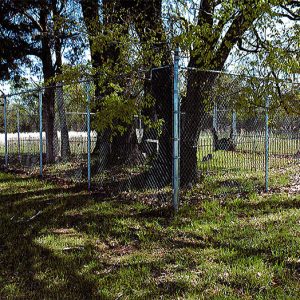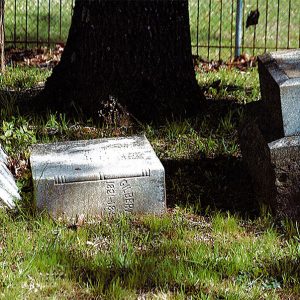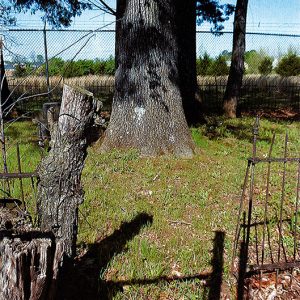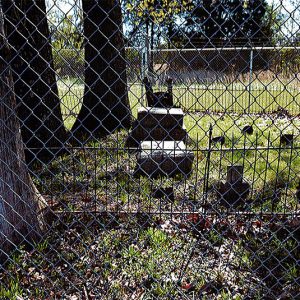calsfoundation@cals.org
Woolsey Farmstead Cemetery
The Woolsey Farmstead Cemetery is located in western Fayetteville (Washington County), near the Woolsey Wet Prairie Preserve. It was listed on the National Register of Historic Places on September 21, 2020.
The small family cemetery, which covers less than one acre, is in the northeastern corner of an open field that was originally part of the farmstead of the Woolsey family, who were early settlers in the area of present-day Farmington (Washington County), arriving in 1830. There is a small grove of trees within the bounds of the cemetery, which causes it to stand out from the surrounding fields. The area around the cemetery that is not cultivated fields is densely wooded. Within the wrought-iron fence, there is a large stone marker, which has fallen over, and several smaller markers made of granite or fieldstone. A modern chain-link fence encircles the property.
Believed to have been established in 1845 with the death of thirteen-year-old Green S. Woolsey, the eleventh child of Samuel and Matilda Woolsey, the cemetery contains at least seven burials. At the center of the cemetery is a large family marker engraved with the names of the people buried there. Erected in the early twentieth century, the monolithic marker is composed of three primary sections and is the only marker in the cemetery that has any formal decoration to its design. The base of the monument is rusticated granite with a short, upward beveled layer topped by a smaller rectangular section of stone that has the name “WOOLSEY” etched into it. This base section is the only part of the marker in its original position. Laying just to the west of this is the middle section of the monument, which is rectangular with decorative spindle-like carvings on each of four the corners. Each of the four sides of this section has a different engraving. The west side (before the monument was toppled) reads “SAMUEL: 1791–1858,” “MATILDA: 1794–1871,” and “SAMUEL & MATILDA WOOLSEY SETTLED ON THIS FARM 1830.” The former eastern side reads “JANE WOODRUFF:1819–1848,” “LOURANA: 1825–1908,” and “LOUISA M.:1827–1919.” The narrower former north and south sides have one inscription on each. The north side reads “GILBERT C.: 1821–1851,” and the south side reads “GREEN S.: 1832–1845.” The third and final piece is the capstone (which fell to the ground at some point). This section has a bed-mould base with stylized scalloped design cornice above and is topped with a hipped roof section.
There are two other cut granite markers within the grounds of the cemetery. They are located in the southwest corner of the cemetery and have the initials “S.W.” and “M.W,” for Samuel and Matilda Woolsey, engraved upon them. It is believed that these two markers were installed around the same time as the large family marker, roughly between 1908 and 1919. There are also five fieldstone markers within the cemetery. All the markers are located in the southern half of cemetery, with the northern half being devoid of any known burials.
After Louisa died in 1919, with Lourana having already died, the Lester and Vella Broyles family bought the land encompassing the cemetery, and several generations of the Broyles family lived on the land until it was sold to the city of Fayetteville in 1999.
For additional information:
The Goodspeed Biographical and Historical Memoirs of Northwest Arkansas. Chicago: Goodspeed Publishing Co., 1889.
Johnson, Antoinette Fiduccia, and Aaron Ruby. “Restoring the Woolsey Farmstead of the 1830s Washington County.” Flashback 70 (Fall 2020): 110–117.
Neal, Joseph C. History of Washington County, Arkansas. Springdale, AR: Shiloh Museum, 1989.
“Woolsey Farmstead Cemetery.” National Register of Historic Places registration form. On file at Arkansas Historic Preservation Program, Little Rock, Arkansas. Online at http://www.arkansaspreservation.com/National-Register-Listings/PDF/WA1731.nr.pdf (accessed December 31, 2020).
Jacob Evans
Revival Architecture


 Woolsey Farmstead Cemetery
Woolsey Farmstead Cemetery  Woolsey Farmstead Cemetery Detail
Woolsey Farmstead Cemetery Detail  Woolsey Farmstead Cemetery Entrance
Woolsey Farmstead Cemetery Entrance  Woolsey Farmstead Cemetery Gravestones
Woolsey Farmstead Cemetery Gravestones 



Comments
No comments on this entry yet.